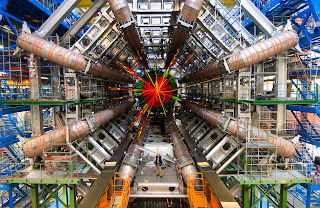 |
| Existing standard hadrons and exotic hadrons. At the B Factory experiment, a series of new exotic mesons containing charm quarks (c) have been discovered. Unlike these exotic mesons, the newly discovered Zb particles contain bottom quarks (b) and have an electric charge. If only one bottom quark and one anti-bottom quark ( b ) are contained, the resulting particle is electrically neutral. Thus, the Zb must also contain at least two more quarks (e.g., one up quark (u) and one anti-down quark ( d )). |
The Belle B Factory experiment, which began in 1999 with the aim of elucidating the origin of particle-anti-particle symmetry breaking (CP violation), has contributed to the Nobel Prize in Physics in 2008 awarded to Drs. Kobayashi and Maskawa. Moreover, data obtained from electron--positron collisions with the world's highest luminosity achieved at the KEKB accelerator have resulted in a series of unexpected discoveries of exotic hadrons, opening a new research frontier in particle physics. Data taking at the Belle Experiment has already been completed, but a vast amount of data is still awaiting detailed analysis. Moreover, an upgraded version of the KEKB/Belle Experiment, called SuperKEKB/Belle II is currently being prepared. Belle II aims to collect 50 times more data than the earlier experiment......... See: Belle Discovers New Heavy 'Exotic Hadrons'
Also See:
***
The Belle experiment is a
particle physics experiment conducted by the
Belle Collaboration, an international collaboration of more than 400 physicists and engineers investigating
CP-violation effects at the High Energy Accelerator Research Organisation (
KEK) in
Tsukuba,
Ibaraki Prefecture,
Japan
The Belle detector, located at the collision point of the
e−e+ asymmetric-energy collider (
KEKB), is a multilayer
particle detector. Its large
solid angle coverage, vertex location with precision on the order of tens of micrometres (provided by a silicon vertex detector), good
pion–
kaon separation at the momenta range from
100 MeV/c till few GeV/c (provided by a novel
Cherenkov detector), and few-percent precision electromagnetic
calorimetry (
CsI(
Tl)
scintillating crystals) allow for many other scientific searches apart from CP-violation. Extensive studies of rare decays, searches for exotic particles and precision measurements of
B mesons,
D mesons, and
tau particles have been carried out and have resulted in almost 300 publications in physics journals.
Highlights of the Belle experiment so far include
- the first observation of CP-violation outside of the kaon system (2001)
- observation of:
 and
and 
- measurement of ϕ3 using the
 Dalitz plot
Dalitz plot
- measurement of the CKM quark mixing matrix elements | Vub | and | Vcb |
- observation of direct CP-violation in
 and
and 
- observation of
 transitions
transitions
- evidence for

- observations of a number of new particles including the X(3872)
The Belle experiment operated at the
KEKB accelerator, the world's highest
luminosity machine. The instantaneous luminosity exceeded
2.11×1034 cm−2·s−1. The
integrated luminosity collected at the
?(4S) resonance mass is ~
710 fb−1 (corresponds to 771 million
BB meson pairs). Most data is recorded on the
?(4S) resonance, which decays to pairs of
B mesons. About 10% of the data is recorded below the
?(4S) resonance in order to study backgrounds. In addition, Belle has carried out special short runs at the
?(5S) resonance to study
B
s mesons as well as on the
?(3S) resonance to search for evidence of
Dark Matter and the
Higgs Boson.
The
Belle II B-factory, an upgraded facility with two orders of magnitude more luminosity, has been approved in June 2010.
[1] The design and construction work is ongoing.
See also
External links
References
- ^ KEK press release












